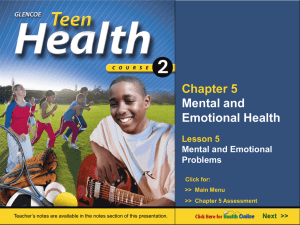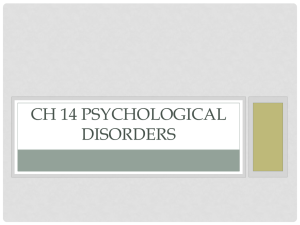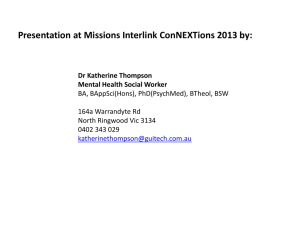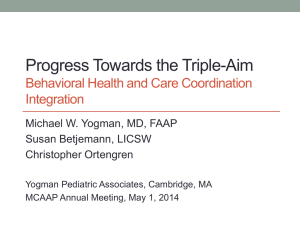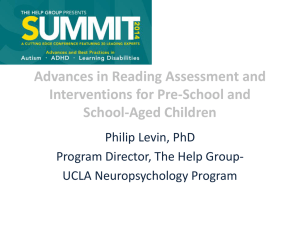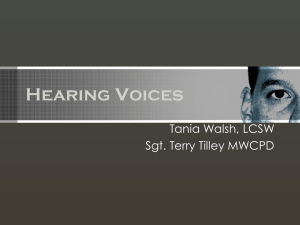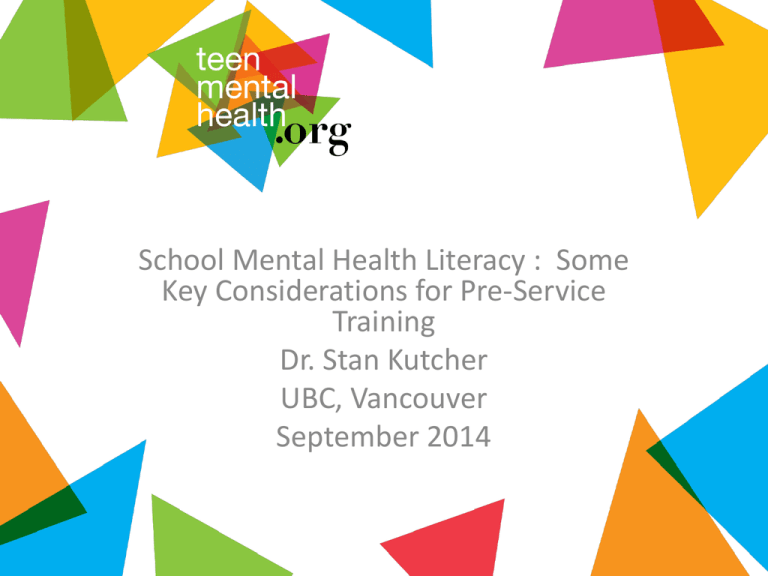
School Mental Health Literacy : Some
Key Considerations for Pre-Service
Training
Dr. Stan Kutcher
UBC, Vancouver
September 2014
MHL in a nutshell
Mental health literacy is the knowledge,
understanding and competencies that
provide the foundation for mental health
promotion, prevention, intervention and
ongoing care that is developmentally
appropriate, contextually applied and best
evidence* supported.
What is Mental Health Literacy?
Also an evolving concept; informed by
realization that it is: complex; must be
developmentally appropriate; contextualized in
its application (one size does not fit all); must be
appropriately measured; must address:
knowledge, attitudes and behavior; must be
demonstrated to be effectively applied (best
scientific evidence); must be part of health
literacy (not a stand alone issue); underpinning
of all mental health related activities.
What Mental Health Literacy must
Embrace
MHL must be built on context and
developmentally appropriate,
pedagogically substantiated approaches
and best science demonstrated results:
addressing: Knowledge, Attitudes and
Behaviours of the receiver
One size does not fit all!
Conceptual Caution
• Mental Health Awareness is not Mental
Health Literacy – at best may be a pre-cursor
to MHL, at worst may be an inhibitor of MHL
• Taking a course or getting information about
mental disorders is not MHL
• Frenetic activity is not a substitute for
knowledge, understanding and self-care
competencies – beware simple solutions to
complex problems
Some basic MHL
• Understanding the Human Brain (humbly as
best as we can)
• Know how to evaluate and understand what
you read about mental health (some common
challenges)
• Understand foundations of how to think about
treatments (apply to all kinds)
• How does what you are doing measure up?
Normal Teen Brain Development:
a primer for health providers
Lenroot & Giedd (2006)
• Play brain video here
SEMANTIC CONFUSION
Mental health condition
Mental health issue
Mental health illness
Mental wellness illness
Mental illness
Mental health
Mental wellness
Mental well-being
Mental wholeness
Mental and social well-being
Mental health problem
Mental disorder
Mental happiness and well-being
UNDERSTANDING MENTAL HEALTH
STATES
.
Mental Disorder/Illness
Mental Health Problem
Mental Distress
No Distress, Problem or Disorder
Clarity is essential: “depression”
Distress
• Unhappy
• Disappointed
• Disgruntled
Problem
• Demoralized
• Disengaged
• Disenfranchised
Disorder
• Depressed
Mental Health State and Type of
Action
• Enhancement of mental well • Health Promotion
being
• Addressing Distress
• Helping build resilience
avoiding protection from stress
• Addressing Mental Health
Problems
• Enhancing Supports, Prevention
• Addressing Mental
Disorders
• Prevention, Best in Class Care
DALYs: Non-Communicable Disease
Contribution – WHO 2005
Children and Adolescent Mental Health
Children and Youth Ages 9-17
Mental Disorder
Six Month
Prevalence (%)
Age = 9-17
Anxiety Disorder
13.0
Mood Disorder
6.2
Disruptive
Behavioral d/os
10.3
Substance Use
Disorders
2.0
Any Disorder
20.9
Child and Adolescent Health:
Comparative Burden of Illness for Mental
Illness
Table: World: DALYS in 2000 attributable to selected causes by
age
Ages 0-9
Ages 10-19
12
29
Malignant Neoplasms
3
5
Cardiovascular Diseases
2
4
Neuro-psychiatric conditions
(including self-inflicted
injuries)
Adapted from: World Health Organization (2003). Caring for children and adolescents
with mental disorders. Setting WHO directions. Page 3, Figure 1. World: DALYs in 2000
attributable to selected causes, by age and sex.
Child and Adolescent Mental Disorders
Up to 21% of children and youth age
9-17 in the US suffer from a mental
disorder (including addictive disorders)
associated with at least minimal
functional impairment
11% of children and youth age 9-17 in
the US suffer from a mental disorder
associated with significant functional
impairment
5% of children and youth age 9-17 in
the US suffer from a mental disorder
associated with extreme functional
impairment
Cross-national Comparisons of the Onset of Psychiatric
Disorders
Age of onset distributions of any anxiety disorders*
Age of onset distributions of any substance use disorders*
*Data for Germany were omitted because
of the narrow age range of the sample
Age of onset distributions of any mood disorders*
12-25
Number of Suicides by Age Group Canada,
2005-2009
600
500
Number of Suicides
400
2005
300
2006
2007
2008
200
2009
100
0
10 to 15 to 20 to 25 to 30 to 35 to 40 to 45 to 50 to 55 to 60 to 65 to 70 to 75 to 80 to 85 to 90
14 19 24 29 34 39 44 49 54 59 64 69 74 79 84 89 and
older
Source: Statistics Canada
What is the Evidence you Need?
What do the following have in common?
• 1 – Lemon juice soaked sponges
• 2 – Pessaries made from: acacia root and
honey; donkey milk; crocodile dung
• 3 – Libations of: hot mercury; camel spittle
What do these have in Common?
•
•
•
•
Charles Goodyear
Margaret Sanger
Katherine McCormick
Frank Cotton/Carl Djerassi/John Rock and
Edris Rice-Wray/Celso Ramon-Garcia
• The Barbasco Yam
• FDA
• Searle
And there is more!
The Social Context of ENOVID
1 – FDA 1957 – “menstrual disorders”
2 – FDA 1960 – “contraception”
3 - “The Doctors Case Against the Pill’ (1969)
4 – The Nelson Pill Hearings (1970)
5 - Eisenstein vrs Baird (1972) – crimes against
chastity
6 – Our Bodies Ourselves (1970 – Boston Women’s
Health Collective)
7 – The Roman Catholic Church
Enhancing Evidence Based
Interventions
• Necessity to practice/work within a BEST
evidence based framework
• Absence of evidence is not evidence of
absence
• Best evidence based practice is not the same
as evidence based best practice
• “Promising”, “Best Practice” and “Evidence
Informed” – what exactly do those words
mean?
Common Conceptual Challenges
1 – Risk factor and protective factor consideration
as the justification for outcome expectations
2 – The primacy of “linear causation” – “that which
came before caused what happened next”
3 – Wish to find simple solutions to complex
problems (the emotional drive for certainty - doing
something vrs doing the right thing)
4 – The attributional bias
5 – Confusing “symptoms” with “syndrome”- for
example: “depression” with “Depression”
Linear Causality = Error
Symptoms begin
Events happen
More events happen
Diagnosis made
MOOD
Common Critical Reading
Challenges
1 – Percentages as reported results
2 – Within group comparisons instead of
between group comparisons
3 – Use of “proxy measures” instead of the key
measure
4 – No “placebo” group (attentional controls)
5 – Abstract and Conclusions are not supported
by the data in the article
Evidence is Hierarchical
RCT
Case Controlled
Natural Prospective
Case
Case Series
Natural Retrospective
Evidence Level of Health Programmes
A systematic
Review of
Randomized
controlled studies
A randomized
controlled trial
A pseudorandomised controlled trial
(i.e. alternate allocation or some
other method)
A comparative study with concurrent controls
(Non-randomized experimental trial, cohort,
case control, interrupted time series with a
control group)
A comparative study without concurrent controls
(a historical control study, interrupted time series without a
control group)
Case series with either post-test or pre-test/post-test outcomes
Background information/expert opinions
OJP “What Works Repository”
Classification Framework
RCT
No known harmful side effects
Adequately addressed threats to internal validity
Random assignment
Large sample (Sufficient power?)
Intervention described
Independent evaluation
Adequate outcome measure
Differences described
Modest attrition (≤20%)
Intent-to-treat analysis
Accurate interpretation of results
Statistically significant positive effect of program
Effect sustained for ≥1 year post-program
≥1 external replication (RCT)
OJP “What Works Repository”
Note:
The OJP What Works Repository classifies programs into 6 levels of evidence of
effectiveness and 3 levels of readiness for dissemination, using rigorous scientific
criteria.
Ineffective
Insufficient
evidence
Not ready for dissemination
Inconclusive
evidence
Promising
Fully prepared for limited
dissemination
Effective with
reservation
Effective
Fully prepared for widespread
dissemination
OJP “What Works Repository”
Two Examples of School Based Suicide Prevention Programs
Signs of
Suicide
Prevention
Ineffective
Insufficient
evidence
Inconclusive
evidence
Promising
Effective with
reservation
Effective
Yellow Ribbon
Suicide
Prevention
Signs of
Suicide
Prevention
Not ready for dissemination
Yellow Ribbon
Suicide
Prevention
Fully prepared for limited
dissemination
Fully prepared for widespread
dissemination
Treatment Categories
1) Standard
2) Complementary
3) Alternative
1) Standard Treatments
• Scientific evaluations (RCT)
• Effective/Safe*/Pure*
• Usually regulated (medicine therapy)
• Ongoing systematic reviews
• Professional endorsement/standards of care
• Ongoing monitoring (medicine therapy)
• Big business - good return on investment (ROI)
2) Complementary
Treatments
• In addition to Standard Treatments, usually
does not qualify as a Standard Treatment
• Big business - excellent ROI
• Adds value:
•Improves Standard Treatment effect
•Decreases Standard Treatment side effect
•Targets different domain
3) Alternative Treatment
• Instead of a Standard Treatment
• Does not qualify as a Standard
Treatment
• Is not used as a Complementary
Treatment
• May or may not add value (effective,
safe, pure)?
• Big business – outstanding ROI
More Key Treatment
Concepts
Placebo
Nocebo
How do we determine
intervention impacts?
• Odds ratio
• Effect size
• NNT
• NNT, NNH
Intervention: Magnitude of Effect
Hurricane Juan, Halifax, 2003
Intervention: Magnitude of Effect
Hurricane Katrina, New Orleans, 2005
What Must Programs
Demonstrate?
•
•
•
•
Effectiveness
Safety
Cost effectiveness
Feasibility
ESCeF Criteria
Working within EXISTING Systems
• Use a system – strengthening model instead of
developing a parallel system model
• Focus on reproducibility of results not on fidelity
of application
• Build on existing strengths (in schools: teachers;
administrators; community links; etc.)
• Integrate interventions as much as possible into
existing site ecologies (embed not
parachute)
What is Mental Health Literacy for Youth
and Educators (Middle and Secondary
Schools)?
• Understand how to obtain and maintain good
mental health
• Understand and identify mental disorders and
their treatments
• Decrease stigma
• Enhance help-seeking efficacy: know where to go;
know when to go; know what to expect when you
get there; know how to increase likelihood of
“best available care” (skills and tools)
Mental Health & High School Curriculum Guide
A Mental Health Literacy Program for Students and Teachers
Mental Health & High
School Curriculum Guide
is the first and only
evidence based mental
health literacy resource to
address youth mental
health in a systematic
manner for Canadian
schools, with the focus on
students and teachers
Guide: Curriculum Resource
• Builds on the three core components of schools
globally: students; teachers; curriculum
• A resource that can be embedded into existing
health or other appropriate courses – not a program
in a box
• Delivered by usual classroom teachers who have
been trained in the use of the resource – builds on
traditional pedagogic practices
• Imparts MHL to students and teachers using existing
resources and in school activities
• Mental Health by Stealth
Table 1: The Guide Outcomes
Province
Year
Participants Increased Knowledge
Improved Attitudes
Nova Scotia Program
evaluation
2012-2013
218
Educators
Yes
p<0.0001,
d=1.85
Yes
p<0.0001,
d=0.51
Ontario
Crosssectional
study
2012
409
Students
Yes
p<0.001,
d=0.9;
p<0.001*,
d=0.73*
Yes
p<0.001,
d=0.25;
p<0.007*,
d=0.18*
Program
evaluation
2013
74
Educators
Yes
p<0.001,
d=1.48
Yes
p<0.03,
d=1.26
Crosssectional
study
2013
175
Students
Yes
p<0.0001,
d=1.11;
p<0.001*,
d=0.91*
Yes
p<0.001,
d=0.66;
p<0.001*,
d=0.52*
Program
evaluation
2013
25
Educators
Yes
p<0.0001,
d=2.03
Yes
NS,
d=0.21
Alberta
Study type
*: two month follow-up results
Your Challenge Now
• From the following list of well – known programs,
decide: evidence is: high; medium; low/unknown
for effectiveness and safety
• Guess at the cost: $$$; $$; $
• Rank order (1 to 5)
• Programs: Drug Abuse Resistance Education (DARE);
Tribes; Stop Now and Plan (SNAP); Lion’s Quest; The
Virtues Project (UN endorsed)
LeBlanc et al. Social and Emotional Learning Programs for
Schools; CPSC Atlantic; 2013
WRAP UP
DISCUSSION
TeenMentalHealth.org
teenmentalhealth1
@TMentalHealth
info@TeenMentalHealth.org





